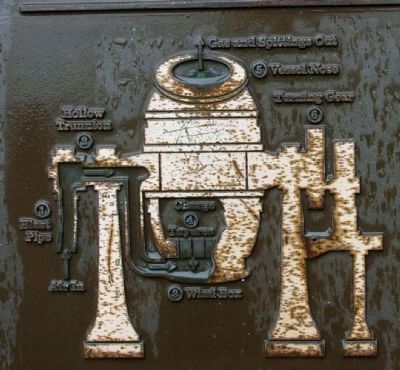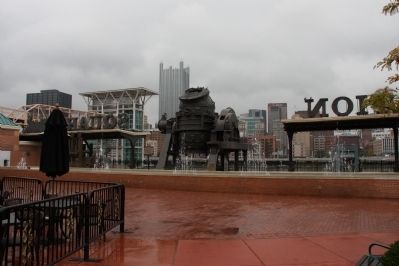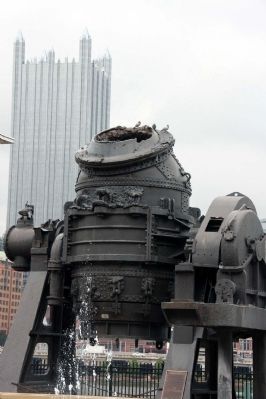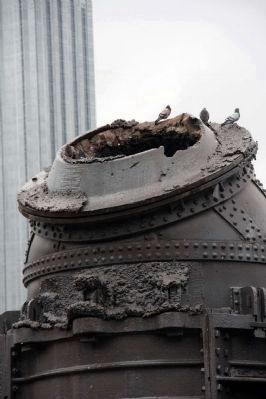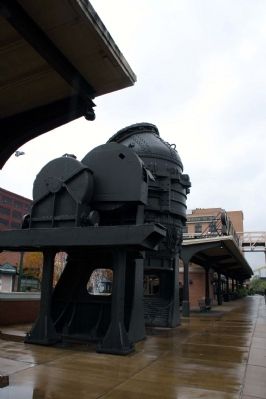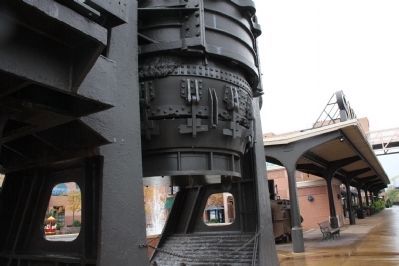South Shore in Pittsburgh in Allegheny County, Pennsylvania — The American Northeast (Mid-Atlantic)
Bessemer Converter
In the Bessemer process, molten blast furnace iron is converted to steel by burning out carbon and other impurities with a blast of air forced through the molten bath by tuyeres.
The Bessemer and similar processes were developed during the 1840 - 1860 but not commercially utilized until 1864 with the installation of the first successful plant at Wyandotte, Michigan. This ushered in the “Age of Steel” and vessels of this type became the workhorse of the American steelmaking industry as well as abroad. By 1883, close to 1.5 million tons of steel were processed in bessemers, which accounted for over 88% of the United States total production. Bessemer steel production peak in 1906 at over 12 million tons accounted for 52% of United States total production, with about 5 million tons being produced in Pennsylvania, mostly in the Pittsburgh area. With the advent the other steel making processes, bessemer steel production in the United States became negligible by the late 1960’s.
This restoration was initiated by the Association of Iron and Steel Engineers, William C. Friesel, Managing Director. The Association funded the dismantling, transport and re-erection of the bessemer on this site. Gerald E. Peckich and Arthur Silverman donated the vessel. PECOR Division, Pennsylvania Engineering Corporation, fabricators of the original vessel, redesigned installed critically missing parts.
In the Bessemer process, air at 20 to 35 pounds per square inch pressure enters at the blast pipe (1), passes through the hollow trunnion (2), then down to the wind box (3), which distributes it to the Tuyere (4), passes through the molten iron charge and after combining with the carbon, silicon and manganese is discharged from the nose of the vessel (5). A complete blow could be accomplished and from 8 to 12 minutes. After bowling, the vessel is tilted by the turning gear (6), and the steel is poured into a ladle for teeming into ingots.
Topics. This historical marker is listed in this topic list: Industry & Commerce. A significant historical year for this entry is 1930.
Location. 40° 26.058′ N, 80° 0.279′ W. Marker is in Pittsburgh, Pennsylvania, in Allegheny County. It is in South Shore. Marker can be reached from Station Square East. This plaque is attached to one of the legs of the Bessemer converter in the Bessemer Courtyard in Station
Square in Pittsburgh, PA. Paid parking is available within walking distance of the marker. Station Square is a 52 acre indoor and outdoor shopping, dining and entertainment complex on the Monongahela river. Touch for map. Marker is in this post office area: Pittsburgh PA 15219, United States of America. Touch for directions.
Other nearby markers. At least 8 other markers are within walking distance of this marker. Clinton Furnace (here, next to this marker); Commerce Court (within shouting distance of this marker); P & LE Terminal (about 400 feet away, measured in a direct line); Chuck Muer (about 500 feet away); Rev. John McMillan (about 500 feet away); John A. Roebling (about 500 feet away); Modern Naturalized Garden (about 700 feet away); Railings from the Brady Street Bridge (about 800 feet away). Touch for a list and map of all markers in Pittsburgh.
Also see . . .
1. Bessemer process. Wikipedia (Submitted on November 23, 2012, by Byron Hooks of Sandy Springs, Georgia.)
2. Sir Henry Bessemer. Wikipedia (Submitted on November 23, 2012, by Byron Hooks of Sandy Springs, Georgia.)
Credits. This page was last revised on February 2, 2023. It was originally submitted on November 23, 2012, by Byron Hooks of Sandy Springs, Georgia. This page has been viewed 1,157 times since then and 105 times this year. Photos: 1, 2, 3, 4, 5, 6, 7. submitted on November 23, 2012, by Byron Hooks of Sandy Springs, Georgia. • Bill Pfingsten was the editor who published this page.

